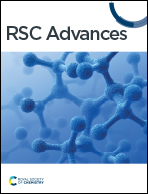Photo-enhanced growth of lead halide perovskite crystals and their electro-optical properties†
Abstract
Organic–inorganic hybrid perovskites have attracted much attention for opto-electronic applications due to their low trap density, strong light absorption, and superior charge transport performance. Generally, the high efficiency of perovskite electro-optical thin films depends on their high-quality perovskite single crystals. In this work, the external illumination is applied on the perovskite single crystals growing in solution. It was shown that larger size CH3NH3PbI3 single crystals can be obtained under illumination conditions. In addition, CH3NH3PbI3 films are prepared by a one-step spin coating process under illumination, the crystal size and film quality of which have been obviously improved due to the effect of illumination in the film forming process. The efficiency of the average cells based on CH3NH3PbI3 films increased from 15.2% for the normal conditions to 17.7% for the illumination one, which is consistent with the light enhanced growth of CH3NH3PbI3 single crystals in their solution. The “photo-inhibition nucleation” mechanism is proposed to explain the light-induced enhancement of perovskite crystal growth.



 Please wait while we load your content...
Please wait while we load your content...